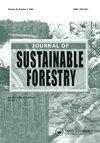基于亚马逊木材残留物天然染料的面部生物嗅觉
IF 1.8
4区 农林科学
Q3 FORESTRY
引用次数: 0
摘要
摘要几种具有抗氧化和抗炎潜力的黄酮类化合物在木材中的存在可能在生物锇工业中有着可行的应用。本文研究了将亚马逊地区主要商业化物种——香杜(cumaru)、胡杨(Manilkara huberi)、巴西樱桃(Hymenaea courbaril)和沙冬青(Handroanthus serratifolius)——的木材残留物改性,以获得用于面部生物化学开发的天然染料的技术可行性。对于每个染料样品,测定了酚类化合物的植物化学图谱以及芦丁和槲皮素中表达的总黄酮含量(ug mL–1)。木渣提取物的得率分别为:黄瓜6.5%,铁木8.1%,巴西樱桃16.3%,黄皮8.8%。理化性质符合官方药典。薄层色谱分析显示存在黄酮类化合物(槲皮素)和可水解单宁(没食子酸)。所有物种的芦丁和槲皮素中表达的总黄酮含量的浓度分别在0.106至7.5和0.1至3.12微克/毫升-1之间。具有适合面部使用的感官特性(外观、颜色和气味)的面部生物气味制剂可以从铁木、巴西樱桃和黄色ipe染料中获得。因此,亚马逊物种木材残留物再利用是一项创新和可持续的技术战略,旨在为亚马逊生物多样性的生物产品增加价值,为该地区的社会经济发展做出贡献。本文章由计算机程序翻译,如有差异,请以英文原文为准。
Facial Biocosmetics Based on Natural Dyes from Amazon Wood Residues
ABSTRACT The occurrence of several flavonoids with antioxidant and anti-inflammatory potential properties in wood may have a viable application in the biocosmetic industry. This paper studies the technical viability of redirecting wood residues of the main commercialized Amazonian species, Dipteryx odorata (cumaru), Manilkara huberi (ironwood), Hymenaea courbaril (Brazilian cherry) and Handroanthus serratifolius (yellow ipe), to obtain natural dyes for facial biocosmetics development. For each dye sample, phytochemical profile of phenolic compounds and the total flavonoids content expressed in rutin and quercetin (ug mL–1) was determined. Wood residues extract yield was 6.5% for cumaru, 8.1% for ironwood, 16.3% for Brazilian cherry and 8.8% for yellow ipe. The physical-chemical properties were compliant with the official compendia. TLC-analysis revealed the presence of flavonoids (quercetin) and hydrolyzable tannins (gallic acid). Concentration of total flavonoids content expressed in rutin and quercetin varied between 0.106 to 7.5 and 0.1 to 3.12ug.mL–1, respectively, for all species. Facial biocosmetic formulations with organoleptic properties (appearance, color and odor) suitable for facial use could be obtained from ironwood, Brazilian cherry and yellow ipe dyes. Therefore, Amazon species wood residues reuse is an innovative and sustainable technological strategy to add value to bioproducts of Amazon biodiversity, contributing to the region’s socio-economic development.
求助全文
通过发布文献求助,成功后即可免费获取论文全文。
去求助
来源期刊

Journal of Sustainable Forestry
Social Sciences-Geography, Planning and Development
CiteScore
3.90
自引率
12.50%
发文量
42
期刊介绍:
Journal of Sustainable Forestry publishes peer-reviewed, original research on forest science. While the emphasis is on sustainable use of forest products and services, the journal covers a wide range of topics from the underlying biology and ecology of forests to the social, economic and policy aspects of forestry. Short communications and review papers that provide a clear theoretical, conceptual or methodological contribution to the existing literature are also included in the journal.
Common topics covered in the Journal of Sustainable Forestry include:
• Ecology, management, recreation, restoration and silvicultural systems of all forest types, including urban forests
• All aspects of forest biology, including ecophysiology, entomology, pathology, genetics, tree breeding, and biotechnology
• Wood properties, forest biomass, bioenergy, and carbon sequestration
• Simulation modeling, inventory, quantitative methods, and remote sensing
• Environmental pollution, fire and climate change impacts, and adaptation and mitigation in forests
• Forest engineering, economics, human dimensions, natural resource policy, and planning
Journal of Sustainable Forestry provides an international forum for dialogue between research scientists, forest managers, economists and policy and decision makers who share the common vision of the sustainable use of natural resources.
 求助内容:
求助内容: 应助结果提醒方式:
应助结果提醒方式:


